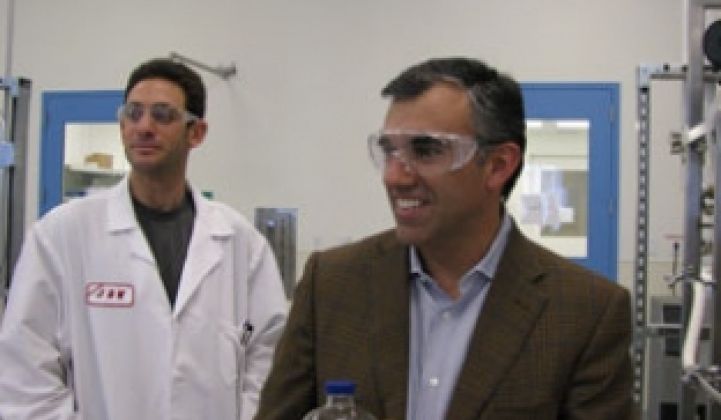IPO fever is gripping greentech, and rumors are circulating that Amryis, the company that made synthetic biology a household word, could be one of the next to file.
The company, which was spun out of research conducted at UC Berkeley, could file the necessary documents for an IPO in the second quarter, according to sources. So far, Amyris has raised around $165 million. Codexis, which makes enzymes for fuel production, filed its S-1, the form that is the official prelude to an IPO, in December, and Mascoma, which wants to make cellulosic ethanol, has been trying to raise a few hundred million from the private equity markets to pay for a plant.
Amyris specializes in concocting microbes that feed on sugars and secrete made-to-order hydrocarbon molecules that can be converted into jet fuel, industrial chemicals or biodiesel. In nature, yeast ordinarily eat sugar and produce alcohol. (In fact, fine wine is what happens when microbes go to the bathroom, but don't expect a sommelier to tell you that.) Developing a genome so that yeast secrete hydrocarbons instead of beer or wine is Amyris' secret sauce.
Amyris, potentially, will be able to produce biodiesel that it can sell for $2 a gallon at wholesale, CEO John Melo told us in late 2008.
The first product out of the company was an artificial version of artemisinin, an antimalaria drug that drew millions in support from the Bill and Melinda Gates Foundation. The metabolic pathway for developing fuel is different, but similar to the one used for making artemisinin.
"Some people refer to it (synthetic biology) as metabolic engineering on steroids," Jack Newman, one of Amyris' founders, told us in a previous discussion. "There are a few things we have adopted from plants. Plants are great for making hydrocarbons."
Although we spoke to Melo and Newman earlier, we didn't talk to either of them for this story.
If anything, the company has been notably active lately. In December, it paid $82 million to Brazil's São Martinho Group for a 40-percent stake in an ethanol mill project that the parties hope will be operational by 2011 or 2012. The Brazilian company already controls three ethanol plants that make about 600 million liters (158 million gallons) of ethanol per year.
Five days later, it entered into letter-of-intent agreements with three other Brazilian companies -- Acucar Guarani, Bunge Limited and Cosan -- to produce ethanol and high-value chemicals. Later that same month, it hired a chief commercial officer (Peter Boynton) and a COO (Mario Portela).
The company is also working with the state of Alabama to build sugarcane plantations and yeast-powered fuel refineries in that state. Amyris does not want to license its technology. Instead, it wants to produce fuel itself in tandem with industrial partners and sell it, initially to large fleet buyers.
If Amyris does file for an IPO, and Codexis follows through a public offering, it will mark a watershed moment in the biofuels industry. Investors have plunked hundreds of millions into cellulosic ethanol and biodiesel companies in the last five years. So far, though, only a few of the companies that have been the beneficiaries of those investments have produced much fuel, and to date, no one is really producing large, commercial volumes. Successful IPOs could jump-start the market by giving these two companies the needed capital to build factories. The U.S. is also woefully behind in meeting its own biofuel mandates, so expect some support and encouragement from the government, as well.
Amyris has said that the company could produce as much as 600 to 800 gallons of fuel per acre. That's far better than corn ethanol and somewhat on par with sugarcane ethanol. However, it is lower than what cellulosic ethanol and algae growers say they will get. Some algae companies claim they will get 5,000 gallons per acre per year.
The road to fuel nirvana has long been paved with delays. Back in 2008, Melo said he hoped the company would be able to produce 200 million gallons or so out of its first Brazilian plant. Hey, wait a minute. 2010 is now.



